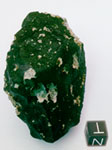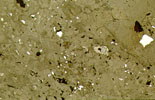
| MetSoc Home Publications Contacts |
 |
||
|
||
| Queen Alexandra Range 97014 | |||||||||||||||||||||
|---|---|---|---|---|---|---|---|---|---|---|---|---|---|---|---|---|---|---|---|---|---|
| Basic information | Name: Queen Alexandra Range 97014 This is an OFFICIAL meteorite name. Abbreviation: QUE 97014 Observed fall: No Year found: 1997 Country: Antarctica [Collected by US Antarctic Search for Meteorites program (ANSMET)] Mass:  142.3 g 142.3 g | ||||||||||||||||||||
| Classification history: |
This is 1 of 136 approved meteorites classified as Eucrite-unbr. [show all] Search for other: Achondrites, Eucrites, and HED achondrites | ||||||||||||||||||||
| Comments: | Field number: 11387 | ||||||||||||||||||||
Writeup |
Writeup from AMN 22(1):

Macroscopic Description: Kathleen McBride 60% of this Eucrite’s exterior is covered with shiny vesicular black fusion crust. Some areas are pitted, showing evidence of plucking of clast material. The interior is very soft and friable. It is light gray in color with very minor amount of metal and rust. It has a sugary texture with numerous black glass veins and mafic minerals. White inclusions and transparent-colorless to yellow-orange crystalline minerals are visible. Thin Section (, 2) Description: Tim McCoy: 


The section consists of fine-grained (100-200 um) pyroxene and plagioclase with minor SiO2. The pyroxene is twinned with compositions of FS65Wo2 and Fs30Wo41. Both Fe, Ti-oxide and iron metal occur in the unusually high level of a few volume percent combined. The meteorite is an unbrecciated eucrite. | ||||||||||||||||||||
| Data from: MB83 Table A1 Line 329: |
|
||||||||||||||||||||
| Catalogs: |
| ||||||||||||||||||||
| References: | Published in Antarctic Meteorite Newsletter 22(1) (1999), JSC, Houston Published in Meteoritical Bulletin, no. 83, MAPS 34, A169-A186 (1999)
| ||||||||||||||||||||
| Photos: |
| ||||||||||||||||||||
| Geography: |
Statistics: This is 1 of 44543 approved meteorites from Antarctica (plus 3802 unapproved names) | ||||||||||||||||||||
| Proximity search: | |||||||||||||||||||||
| Also see: |
This lists the most popular meteorites among people who looked up this meteorite.
| ||||||||||||||||||||
| Revision history: |
This lists important revisions made to data for this record.
| ||||||||||||||||||||